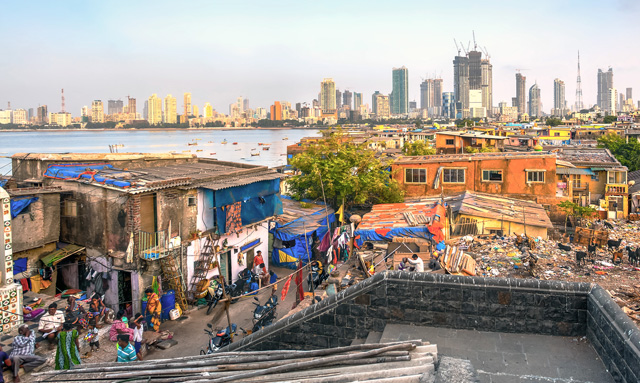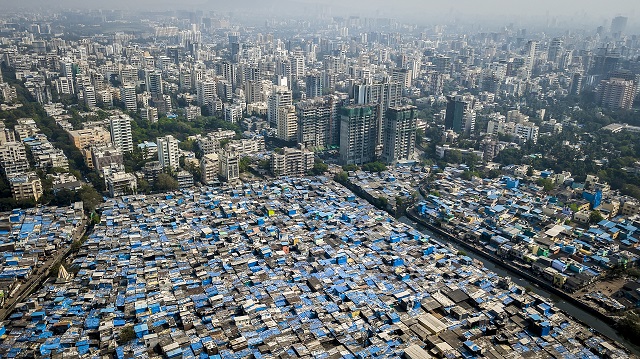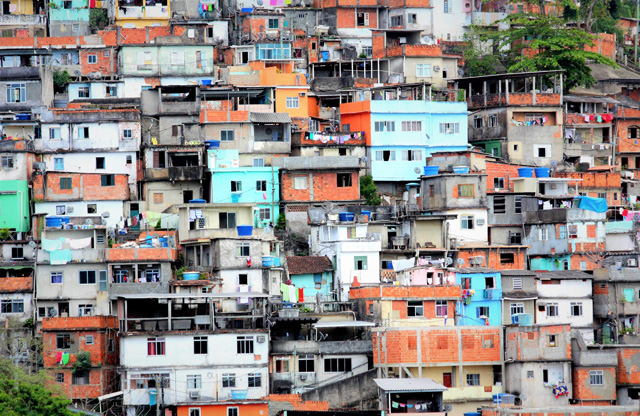
More than 1 billion people live in slums and informal settlements in developing cities like Mumbai, India. Social distancing may be impossible for many of them. Photo by Adrian Catalan Lazar/iStock
The COVID-19 pandemic has created a disruptive new normal for everyone through shelter-in-place orders and social distancing guidelines. But for the billions of urban poor, these guidelines aren’t just burdensome; they’re essentially impossible.
Social distancing is a critically important response to the pandemic, but it also assumes that residents have adequate space, services and social safety nets to survive such an order. This is simply not the reality across cities in Asia, Africa and Latin America.
More than 1 billion people live in slums and informal settlements globally. As much as 50-80% of employment is informal in developing cities, from street vendors to minibus drivers to migrant workers. Many of these families are essentially surviving day-to-day, living in dense neighborhoods with unreliable and often shared access to basic services like water, sanitation and electricity. Many don’t have bank accounts, basic employment contracts or insurance. Their incomes and workplaces are not on any government agency’s radar. In short, they lack the resources to survive without defying lockdown orders.
The shortcomings of recent social distancing orders are evident in cities like New Delhi, Bangkok, Lagos, Mexico City and Rio de Janeiro, where millions of residents feel their lives have been upended with little protection or access to support. The helplessness is widespread as families prepare for the worst.
Recognizing and addressing the stark reality of urban inequality is essential for addressing the current pandemic. It can also help cities build back better and be more resilient to future crises.
Urban Inequality, India and COVID-19
Perhaps no situation is more dire than in India, where a national lockdown with little notice ordered 1.3 billion people to self-isolate for at least 40 days. With the current guidance – from washing hands frequently to staying put – it’s unclear how the country’s 460 million urban residents will cope.
Between 152-216 million people in India live in dense informal housing, or slums. It is common to see lines of shacks for migrant workers crowded at a river’s edge and other hazard-prone areas. WRI’s World Resources Report documented how one slum in Bangalore is 12 times denser than the city average, housing 140,000 people per square kilometer. In 2018, only 60% of residents could access piped water – and even then, water was only available in taps for an average of two hours per day, two to three days a week.
In another slum in Mumbai, we found more than 2,000 people lacked access to piped water. While more than 70% of residents queued up for water delivered by tanker trucks every few days, the amount of water these households could access was far below the World Health Organization’s recommendation of 50 liters per day in non-emergency situations.
In these circumstances, where washing your hands might mean traveling to a shared tap or drawing from a scarce household supply, self-isolation is not just unfeasible, it may threaten day-to-day survival needs.

What happens to informal workers during the COVID-19 pandemic could affect whole cities – rich and poor alike – and beyond. Photo by Johnny Miller/Unequal Scenes
The same challenges apply to informal workers. A recent survey in Bangalore – where over 70% of the workforce is informal – showed that while many low-income workers were afraid of contracting COVID-19, most felt compelled to continue working for fear of losing income, jobs and the ability to feed their families.
Food insecurity is at an all-time high, and without support, residents are seeing only two choices: starvation or disease risk. A week of dropped wages could mean they will lose their housing. For some, their work is their place of shelter.
Often “invisible” to governments and other urban residents in the best of times, what happens to informal workers like street vendors and domestic workers during the COVID-19 pandemic could affect whole cities – rich and poor folks alike – and beyond. In response to the Modi government’s lockdown order, millions of urban migrant and informal workers are fleeing by foot back to their home villages. This could accelerate the spread of infection across India, putting many rural areas with little health care in immediate danger.
How to Reduce Urban Inequality and Close the Services Gap
In the long term, large-scale investments in infrastructure for water, sanitation, housing and health care are needed around the world to provide growing populations with essential services. And to keep cities humming as economic, cultural and political dynamos, these investments need to specifically improve access for those residents currently being left behind.
But there are short-term strategies to help cities respond now, too. Communities and the citizens that comprise them should be seen as active agents with knowledge, energy and power to shape their response now and in the future. These strategies can give the urban poor more feasible options for getting through this period and help reduce the spread of COVID-19 for everyone:
- City agencies should provide access to basic water and sanitation facilities for free. Things like government-sponsored water tankers, mobile handwashing facilities (as seen in Kigali, Rwanda), and other forms of rapid response – especially in slums and vulnerable neighborhoods – could provide immediate relief. And, wherever possible, agencies should work through existing networks of private and alternate service providers to speed service delivery.
- National governments should process fiscal transfers to states/cities so they can immediately distribute cash assistance – through more creative means than usual, if necessary – to those who need it most. Cash transfers can protect traditional supply chains for essential goods. In Delhi, for example, the local government is setting up shelters and food distribution points to stop rural migration, though not at a fast-enough rate. Governments should leverage existing systems like ration cards to distribute subsidized food and other essential goods, too, but these need to be available for those without secure addresses or bank accounts. Partnerships with private companies can extend a city’s ability to distribute essential goods. In Bangalore, for example, a private food delivery platform has partnered with the state government, NGOs and commercial kitchens to serve 500,000 meals daily.
- Government and private health care providers must step up efforts to provide access to emergency services in cities’ most under-served areas, as well as help those who need to quarantine. Data on access to health services and COVID-19 testing locations can help cities pinpoint hotspots. For example, this map of Delhi highlights which areas would benefit most from emergency clinics. Decision-makers must also consider the effect of curtailed public transport systems, which frontline workers and clients still depend on every day, to get a full picture of urban risk. For example, the city of Bogotá, Colombia, is working with Despacio and NUMO to provide hundreds of free e-bikes to medical workers during the pandemic.
- City governments must work more closely with community leaders and NGOs that work in informal settlements and other at-risk communities – both to better understand what’s happening on the ground and to communicate key health messages. For example, in Nairobi, Kenya, the city is working with UN-HABITAT to provide handwashing facilities in informal settlements. Slum dwellers in Rio de Janeiro have organized to create community solutions, such as donation distribution networks and public information campaigns, while holding authorities accountable for appropriate actions. One slum neighborhood will now have access to shared water taps pumped from back-up reservoirs, thanks to collaboration with the local water utility. Similarly, many urban research organizations and experts are gathering critical spatial data on how this pandemic is changing the landscape of urban risk, including access to health centers and basic housing, water and sanitation facilities. Cities should be aware of their own data limitations and open to new partnerships to help keep up in a fast-evolving situation.
Responding Now Can Create More Resilient Cities in the Future
Providing targeted emergency assistance now can create better preparedness for the future. Establishing deeper and more trusted partnerships with communities can lead to more responsive policies, budget allocations and channels of communication.
Establishing more comprehensive data infrastructure and identifying high-risk locations – such as those where water access is dangerously low – can reduce future public health risks and inform urban planning. In the 1990s, a plague outbreak in Surat, India, led to the creation of a citywide health monitoring cell in the municipal government that’s helping the city respond to COVID-19 today. Likewise, East Asian cities like Hong Kong and Singapore have been able to respond better to COVID-19 in part because of public health surveillance systems set up in response to the SARS outbreak from 2002-2003.
Closing the urban services divide can help cities build back better and more equitably to better withstand the next crisis. Protecting and empowering the most vulnerable helps create more sustainable, thriving environments for everyone.
This blog originally appeared on WRI’s Insights.
Jillian Du is a Knowledge and Data Analyst at WRI Ross Center for Sustainable Cities.
Robin King is Director of Knowledge Capture and Collaboration at WRI Ross Center for Sustainable Cities.
Radha Chanchani is Managing Associate, Research & Practice for the Cities Program at WRI India.







